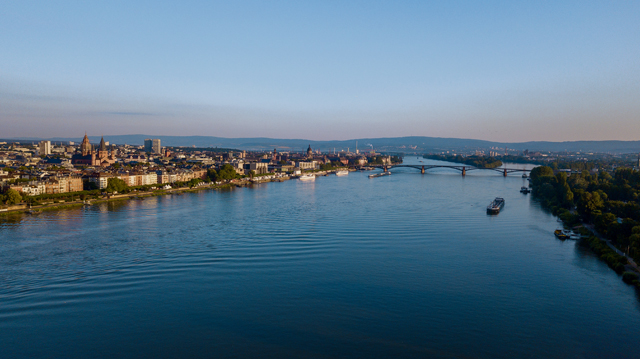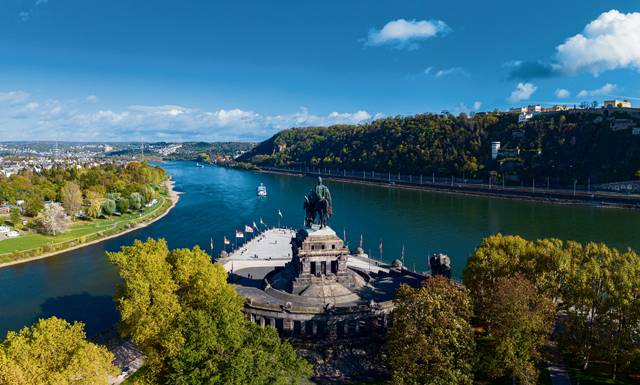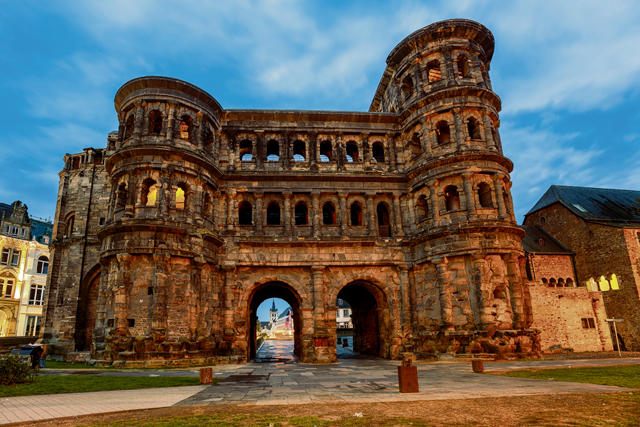
Many members of the Kaiserslautern Military Community have found temporary or even permanent homes in one of the many villages and towns surrounding Kaiserslautern in the heart of Rheinland-Pfalz. You may already be familiar with your immediate vicinity, but there is much more to explore and experience at your “home away from home”.
State of the Art is a series introducing Germany as a whole, but also highlighting an individual state or “Bundesland” every month.
At the end of World War II, Germany was divided into four sectors governed by the United States, Great Britain and France in the West and the Soviet Union in the East of the country.
The Federal Republic of Germany (West Germany) was established on May 23, 1949, with Bonn being the provisional capital. The states of Rheinland-Pfalz, Nordrhein-Westfalen, Hessen, Baden-Württemberg, Bayern, Niedersachsen, Schleswig-Holstein, the City States of Bremen, Hamburg as well as West Berlin, in its geographically isolated location, belonged to the federal republic. The small state of Saarland remained under French government until 1957.
The foundation of the German Democratic Republic (East Germany) followed on Oct. 7, 1949, including the states of Brandenburg, Thüringen, Sachsen-Anhalt, Sachsen, Mecklenburg-Vorpommern and East Berlin as its capital.
After the fall of the Berlin Wall in 1989, both countries were re-united in 1990 to make up the current nation with 16 individual “Bundesländer” and Berlin again became the capital.
Germany is a democratic, federal parliamentary republic, where federal legislative power is vested in the Bundestag (parliament in Berlin) and the Bundesrat (representative body of the states in Berlin). The current government is comprised of a coalition of three parties.
Based on the party colors, it is often referred to as “Ampel-Koaltion” (traffic light coalition). The SPD (Social Democratic Party is represented in red), the FDP (Free Democratic Party in yellow) and the Grüne/Bündnis 90 (Greens/Alliance 90) are green). Olaf Scholz of the SPD as the majority party is the elected Federal Chancellor.
Each month we will feature a different state and provide facts about its history, heritage, industry and commerce, places of interest as well as experiences it offers.
Our journey will start in the State of Rheinland-Pfalz (Rhineland-Palatinate-RLP) home to Ramstein Air Base and a number of U.S. Army installations in or near Kaiserslautern. Rheinland-Pfalz has a size of roughly 19,846 km2 (7,663 sq mil) and a population of 4,093,900. It is in the southwestern part of Germany and borders France, Luxembourg, and a small part of Belgium.
Nature
Rheinland-Pfalz is a state of great diversity and has a lot to offer when it comes to nature. The largest coherent forest region, the Pfälzerwald (Palatinate Forest) stretches from Rheinland-Pfalz into France. The Hunsrück-Hochwald National Park is in the middle of the state, the Eifel further northwest and the Vulkaneifel with dormant volcanoes and volcanic lakes borders Nordrhein-Westfalen to the north. The Dahner Felsenland is a rugged landscape with amazing giant rock formations found in the southeast. Numerous lakes and rivers invite you to swim, relax and discover. Hundreds of castles or ruins along the rivers, in the forests or atop the hills will inspire you to explore and dive into a rich history. Celtic or Roman traces can be found throughout the state, such as the Celtic village in Steinbach just north of Kaiserslautern.
Located on or near the 50th latitude, a unique meso and microclimate plays a vital role when it comes to viticulture. Two thirds of Germany’s wines are cultivated in Rheinland-Pfalz in the Rheinhessen area near Mainz, the Moselle and Saar Valleys near Trier and the vineyards along the “Deutsche Weinstrasse” that stretch from Rheinhessen to Landau.
Mainz the capital, Romans, St. Martin Cathedral and Gutenberg
Mainz is the capital with its “Landtag” (state parliament) situated along the banks of the Rhein River. Malu Dreyer of the SPD (Social Democratic Party) is the Minister President and has been in office since January 2013. It is the largest city in Rheinland-Pfalz with a population of 215,000.
The city has been historically significant for over 2,000 years with traces of an early Celtic settlement. Roman Mainz, called Mogontiacum, developed out of a legion camp, the so-called Castrum, that was founded about 12 B.C. The civilian population eventually grew and brought with it skilled craftsmen and merchants and a port to carry goods was built directly at the Rhein River. The height of the Roman culture lasted for about 200 years until 406 A.D., when Germanic tribes conquered the region.
Ruins of the “Römisches Bühnentheater” (stage theater), Roman stones, a Jupiter column, the Isis und Mater Magna-Heiligtum (sanctuary) and a museum for ancient shipping speak of a flourishing Roman culture. For more info, visit https://www.mainz-tourismus.com/en/explore-enjoy/exploring-the-history-of-mainz/roman-mainz/
The most prominent edifice in the city is located on the historical market square and it is said that construction of St. Martin Cathedral began around the year 990 A.D. It has been restored and redesigned on a number of occasions in its over 1,000-year history, but its mainly Romanesque style has remained. The magnificent church has evidenced the crowning of numerous kings and queens.
During the High Middle Ages around 1300, the city was called “Goldenes Mainz” and had about 20,000-25,000 inhabitants thanks to its flourishing commerce. A century later in 1450 it lost its city rights and was turned into an electoral residence city of little political significance. One of the most prominent characters of the time was Johannes Gutenberg who invented the printing press in Mainz, mass printed the Luther Bible and thus supported the spread of the Protestant Reformation. A replica of the original press can be visited at the Gutenberg Museum (https://www.mainz.de/microsite/gutenberg-museum-en/).
Mainz and Napoleon
After he was crowned as “Emperor of the French” in 1804, Napoleon I visited Mainz for the first time and accounted “Mayence” as one of the 36 most important cities in France. He stayed in the city on numerous occasions and always resided in the “Deutschhaus.” The “Grand Rue Napoleon” was built for his parades and exists as “Ludwigsstrasse” today, while he also built a road that led from Paris to Mainz, traversing Kaiserslautern and commonly referred to as “Kaiserstrasse” (emperor’s road, now L395). His majesty also donated the grand bell in the cathedral which is marked with the inscription “Napoleon the Great.”
Mainz and Fun Facts
The city is also known for its “Fastnacht” (carnival) events and a fountain with a multitude of comical figures is located near the cathedral. Other places of interest include the old town with semi-timbered buildings, the promenade along the Rhein River, the castle, the weekly farmer’s market and the Christmas Market in front of the cathedral.
Don’t miss out on the “Mainzelmännchen” on every pedestrian crosswalk light. The cute comic figures were created in the 1960’s when the ZDF (Zweites Deutsches Fernsehen, the second national television channel) opened in Mainz. A Mainzelbahn (street car) decorated with the figures was established in 2016 that takes commuters directly to the city center. The city is located precisely on the coordinates 50° 0’ 0.0” N,8° 16’ 16.16” E, very favorable for winemaking, and marked with a stone inscription opposite of the Staatstheater. www.mainz.de
Koblenz and the “German Corner”

The second largest city with 105,000 inhabitants is Koblenz, which is located at the mouth of the Moselle River where it flows into the Rhein River. The corner is referred to as “Deutsches Eck” and bears a giant statue of Wilhelm I, the first German emperor on his horse. The impressive fortress Ehrenbreitsein rises high above the city on the east bank of the Rhein River. Koblenz has a quaint old town and is located close to the Vulkaneifel region, well worth a visit. www.koblenz.de
Trier — Germany’s oldest city

Trier, the third largest city with a population of 100,000, is located on the Moselle River, has been home for various cultures for 3,000 years and claims to be the oldest city in Germany. An early Celtic settlement inhabited by the Treveri Clan can be traced back to about 1,000 B.C. According to churchman Hieronymus (347-420 A.D.), Gaelic was still spoken during his time there. The Celts cultivated an early type of wine thanks to the mild temperatures along the Moselle River.
After decades of civil war, Roman emperor Augustus promoted the infrastructure of his newly conquered provinces, including the area along the Moselle. Augustus named the former Celtic settlement “Augusta Treverorum” after the Celts and began constructing the capital city of the Western Roman Empire. The city quickly became a trading hub and an attractive residential area. He had a wooden bridge built in the year 17 B.C. and the dark stone foundations of the bridge can still be seen today. These foundations were re-used during the construction of a new stone bridge in the Middle Ages, and the structure is commonly referred to as the “Römerbrücke” (Roman bridge).
Constantine — a well-traveled emperor
Trier boasts many prominent and well-restored structures built by the Romans, such as the Porta Nigra, the former northern gate, the Kaiserthermen, Barbara and Forum Thermen (Roman baths), as well as an amphitheater. The Constantine Basilica, which is now used as a Protestant Church, was originally built as a throne hall for the emperor around the year 310 A.D. The structure is 67 m (220 ft) long, 27.5 m (90 ft) wide and 33 m (108 ft) high, has no supporting pillars and was equipped with a floor and wall heating system.
Constantine was the most prominent emperor and resided in “Treveris” from 306 to 316 A.D. He then travelled to the East, conquered Byzantium, renamed it Constantinople, and declared it the capital of the Eastern Roman Empire. Constantine died there in the year 337 A.D., and it is noted that he may have converted to Christianity prior to his death. In any case, he laid the foundation of the “Hagia Sophia” as a church, which is now used as a museum and mosque in modern Istanbul.
Other places of interest in the city are the palace and the palace gardens, the picturesque medieval market square, the view over the city from Petrisberg, a cruise up or down the Moselle River from Zurlauben, a quaint fisher village, and the vineyards within the city itself. The mighty cathedral was built on the remains of a Roman palace and the chessboard layout of the city with up to 75,000 inhabitants during Roman times, can still be seen today. Neighbors from Luxembourg and France still call the city “Trèves.” www.trier.de
Trier and Fun Facts
During the Protestant Reformation period, Franz von Sickingen from Landstuhl tried to conquer and secularize the City of Trier in the year 1522. He attacked the city, but upon heavy resistance and retaliation finally had to give up his plan and completely devastated, returned to Castle Nanstein where he died a few years later.
Industry and commerce
While Rheinland-Pfalz is mainly shaped by viticulture and agriculture, such as asparagus, corn, potato and beet as well as dairy farming, there are a number of larger industrial areas as well. The BASF located at Ludwigshafen is the world’s largest chemical plant. Various IT-related businesses have sprung up over the years, automobile engines are assembled and ceramic catalyst parts as well as clothing are produced in Kaiserslautern, cranes, and heavy equipment in Zweibrücken and shoes in Pirmasens.
Other cities and towns to see
Speyer, a mid-size city along the banks of the Rhein River, is well worth a visit. The largest sacral building in the state, the Speyerer Dom, is located there. In addition, a visit to the Technik Museum, Sea Life or a stroll through Adenauer Park or Maximillian Strasse to Altpörtel or a visit at the Jewish Mikveh can be interesting. www.speyer.de
Landau, a former French garrison town with a unique Francophile atmosphere is very close to the border. The grandiose market square and the cozy pedestrian zone invite you to shop or enjoy an afternoon coffee. The zoo with animals from around the world is situated in a woody park and you might discover small booths selling wine or grape juice along the Deutsche Weinstrasse which leads up to the German Weintor. www.landau.de
Neustadt/Weinstrasse is a quaint and very picturesque town with medieval architecture, small alleys and a beautiful market square. The Elvedritsche fountain will surprise you with astonishing fabulous figures and the German wine queen is crowned there every year during the Weinlesefest in October.
A number of small, picturesque villages and towns also lie along the Deutsche Weinstrasse. Visit www.neustadt-weinstrasse.de for more info.
Last but not least, you may already be familiar with the sights in Kaiserslautern, such as the Garden Show and Japanese Garden, impressive Fritz-Walter-Stadium and surrounding recreational areas. Make sure to explore beyond the small towns and villages in your vicinity, venture out, engage in traditional fests and activities to take back fond memories of your stay in the State of Rheinland-Pfalz in the middle of Europe.
For more information about the state of Rheinland-Pfalz, visit https://www.rlp.de/en/english/


